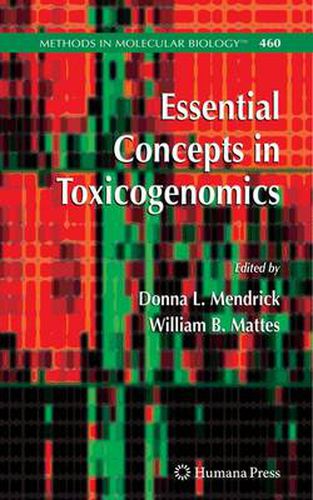Readings Newsletter
Become a Readings Member to make your shopping experience even easier.
Sign in or sign up for free!
You’re not far away from qualifying for FREE standard shipping within Australia
You’ve qualified for FREE standard shipping within Australia
The cart is loading…






This title is printed to order. This book may have been self-published. If so, we cannot guarantee the quality of the content. In the main most books will have gone through the editing process however some may not. We therefore suggest that you be aware of this before ordering this book. If in doubt check either the author or publisher’s details as we are unable to accept any returns unless they are faulty. Please contact us if you have any questions.
The field of toxicogenomics is moving rapidly, so it is impossible at the timeofthiswritingtocompileaclassicmethodstextbook.Instead,wechose to identify experts in all aspects of this field and challenged them to write reviews, opinion pieces, and case studies. This book covers the main areas important to the study and use of toxicogenomics. Chapter 1 speaks to the convergenceofclassicapproachesalongsidetoxicogenomics.Chapter2deals withtheusefulnessoftoxicogenomicstoidentifythemechanismoftoxicity. Chapter3callsattentiontotheissuesthataffectthequalityoftoxicogenomics experiments, as well as the implications of using microarrays as diagnostic devices. The need for appropriate statistical approaches to genomic data is discussed in Chapter 4, and Chapters 5 and 6 describe the use of genomic datatobuildtoxicogenomicmodelsandprovideinsightsfromtheapproaches oftwocompanies.Theimportanttopicofstoringthedatageneratedinsuch experiments and the correct annotation that must accompany such data is considered in Chapter 7. The discussion in Chapter 8 speaks to the use of toxicogenomicstoidentifyspeciessimilaritiesanddifferences.Chapters9and 10dealwiththeuseofgenomicstoidentifybiomarkerswithinthepreclinical andclinicalarenas. Biomarkerswillonlybeusefulifthecommunityatlarge acceptsthemasmeaningful.Consortiaareimportanttodrivethisfunction,and Chapter11discussescurrenteffortsinthisarea.Lastbutnotleast,Chapter12 presentsaperspectiveontheregulatoryimplicationsoftoxicogenomicdataand someofthehurdlesthatcanbeseeninitsimplicationinGLPstudies.Although thisbooktendstofocusonpharmaceuticals,theissuesfacingtoxicologyare sharedbythechemicalmanufacturers,thetobaccoindustry,andtheirregulators. We want to thank our contributors for their generous time and energy in providingtheirinsights.Sadly,wemustnotetheunexpectedpassingofone ofourauthors,Dr.JosephHackettoftheFDA.Joe'scontributionservesasa testimonytohisaccomplishmentsinthisfield,andhisinsightwillbemissed intheyearstocome.
$9.00 standard shipping within Australia
FREE standard shipping within Australia for orders over $100.00
Express & International shipping calculated at checkout
This title is printed to order. This book may have been self-published. If so, we cannot guarantee the quality of the content. In the main most books will have gone through the editing process however some may not. We therefore suggest that you be aware of this before ordering this book. If in doubt check either the author or publisher’s details as we are unable to accept any returns unless they are faulty. Please contact us if you have any questions.
The field of toxicogenomics is moving rapidly, so it is impossible at the timeofthiswritingtocompileaclassicmethodstextbook.Instead,wechose to identify experts in all aspects of this field and challenged them to write reviews, opinion pieces, and case studies. This book covers the main areas important to the study and use of toxicogenomics. Chapter 1 speaks to the convergenceofclassicapproachesalongsidetoxicogenomics.Chapter2deals withtheusefulnessoftoxicogenomicstoidentifythemechanismoftoxicity. Chapter3callsattentiontotheissuesthataffectthequalityoftoxicogenomics experiments, as well as the implications of using microarrays as diagnostic devices. The need for appropriate statistical approaches to genomic data is discussed in Chapter 4, and Chapters 5 and 6 describe the use of genomic datatobuildtoxicogenomicmodelsandprovideinsightsfromtheapproaches oftwocompanies.Theimportanttopicofstoringthedatageneratedinsuch experiments and the correct annotation that must accompany such data is considered in Chapter 7. The discussion in Chapter 8 speaks to the use of toxicogenomicstoidentifyspeciessimilaritiesanddifferences.Chapters9and 10dealwiththeuseofgenomicstoidentifybiomarkerswithinthepreclinical andclinicalarenas. Biomarkerswillonlybeusefulifthecommunityatlarge acceptsthemasmeaningful.Consortiaareimportanttodrivethisfunction,and Chapter11discussescurrenteffortsinthisarea.Lastbutnotleast,Chapter12 presentsaperspectiveontheregulatoryimplicationsoftoxicogenomicdataand someofthehurdlesthatcanbeseeninitsimplicationinGLPstudies.Although thisbooktendstofocusonpharmaceuticals,theissuesfacingtoxicologyare sharedbythechemicalmanufacturers,thetobaccoindustry,andtheirregulators. We want to thank our contributors for their generous time and energy in providingtheirinsights.Sadly,wemustnotetheunexpectedpassingofone ofourauthors,Dr.JosephHackettoftheFDA.Joe'scontributionservesasa testimonytohisaccomplishmentsinthisfield,andhisinsightwillbemissed intheyearstocome.